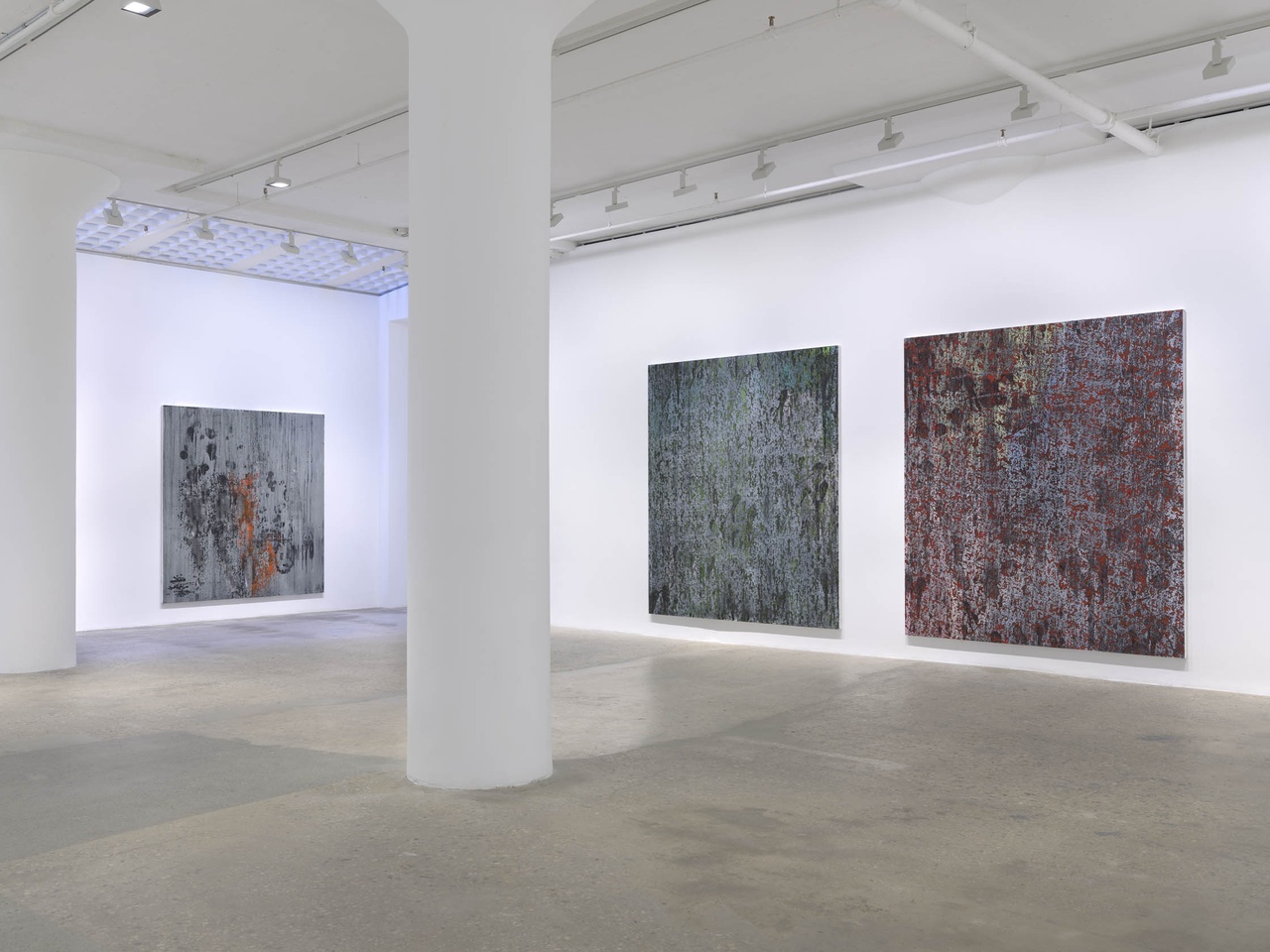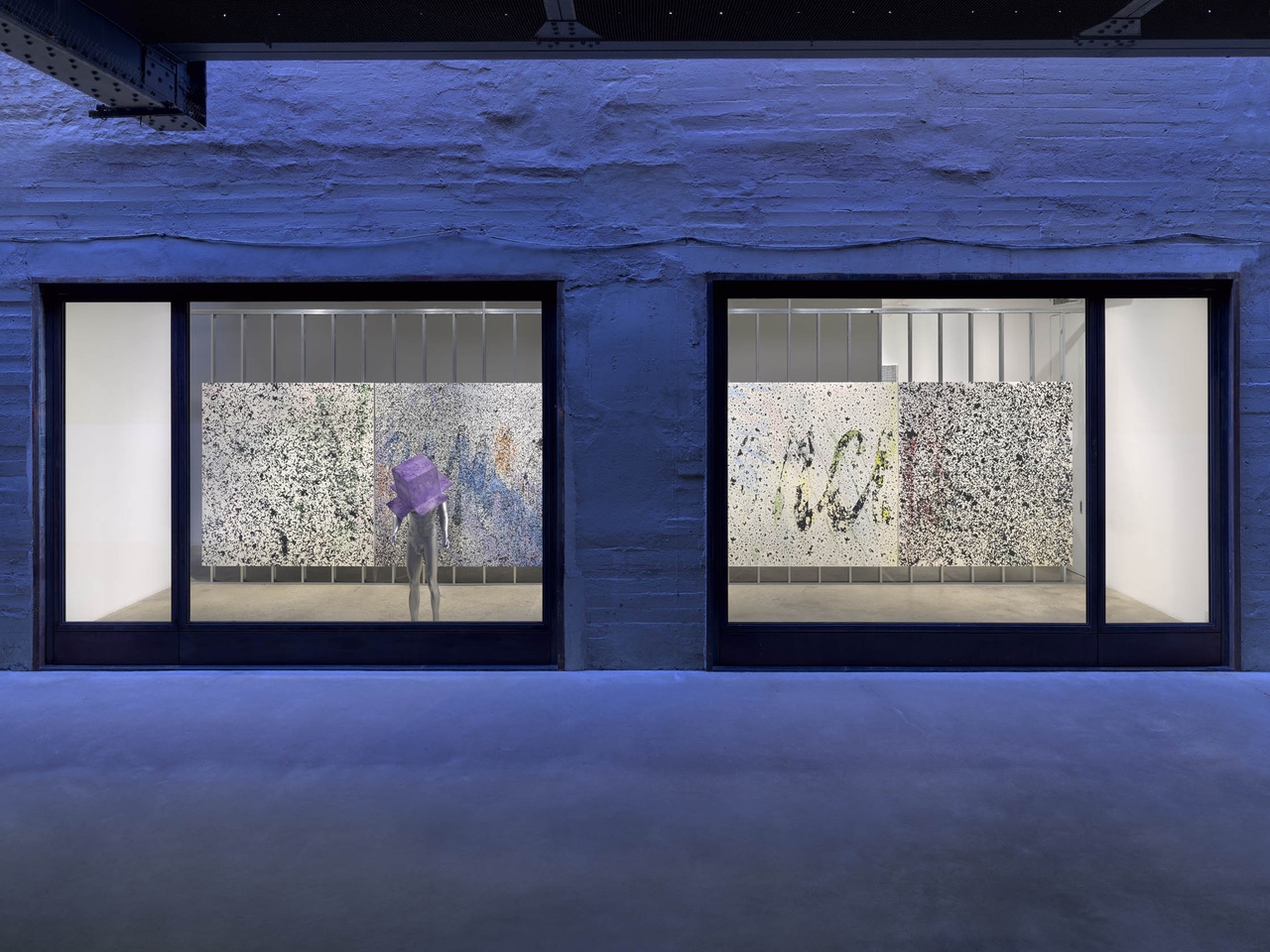TO SERVE PAINTING Tom McDonough on Jacqueline Humphries at Greene Naftali, New York

“Jacqueline Humphries,” Greene Naftali, New York, 2022-23, installation view
The plot of one of the most famous episodes of the old American television series The Twilight Zone hinges on the ambiguity of the title of a book brought to Earth by aliens. When a cryptographer finally manages to translate the visitors’ mysterious language, humanity is relieved to find that it reads “TO SERVE MAN,” which is taken as a guarantee of the aliens’ goodwill. Only too late do the earthlings realize, to their horror, that it is in fact a cookbook, instructing these extraterrestrial beings on how to prepare their human hosts for consumption. The fable was brought to my mind when considering Jacqueline Humphries’s recent work – some of the strongest of her four-decade-long career – as seen at Greene Naftali this past fall, an exhibition that came in the immediate wake of her inclusion in last spring’s 59th Venice Biennale and a seven-year retrospective at the Wexner Center for the Arts, held in fall 2021. All three could be said to have appeared under a similarly ambiguous emblem: TO SERVE PAINTING.
In fact, the phrase is an apt summation of Humphries’s broader approach to her medium. One might think, for example, of her embrace of what might be called “pinakophagia,” her self-cannibalizing of previous paintings, from early attempts to replicate seemingly spontaneous drips – as in Untitled (blue) (1996), included in James Meyer’s 2022 exhibition on “The Double: Identity and Difference in Art Since 1900,” at the National Gallery of Art in Washington, DC – to the more recent translation of her paintings into ASCII code and the extensive use of stencils to duplicate motifs from one work to the next. But we might also recall that she first emerged as a painter in the context of an early 1980s New York art world in which the advanced critical consensus had announced the medium’s demise, a death internalized within painting itself as a form of endgame: “[Y]ou always try to make the last painting in a way,” as Humphries has described it, “the definitive one; one that distills everything that painting was up until that very moment, in a simple and compelling composition. And I like the fact that those ‘last paintings’ are continuously generating new last paintings.” [1]

Jacqueline Humphries, "Neiman Marcus," 2021 and Rachel Harrison, "The Metaverse," 2022
Both last-ness and self-cannibalization are compelling qualities of the new work that was on display at Greene Naftali’s street-level space. The first painting to greet the visitor was a massive, five-panel frieze – eleven-and-a-half meters long – hung on an exposed stud wall and visible only through the windows facing the gallery’s exterior courtyard. The implicit collapse of gallery vitrine and department-store window was reinforced by the work’s title, Neiman Marcus (2021), with its reference to the American luxury chain, and the last-minute addition of a work specially made for the show by Humphries’s colleague Rachel Harrison: her The Metaverse (2022), a silver mannequin with a large cardboard box painted purple covering his head, stood in the space between painting and window, his back to the painting, absorbed instead by whatever virtual delights were being proffered through his headset-cum-dunce cap. Neiman Marcus itself was composed of all-over white-noise patterns whose density varied from panel to panel, across all five of which could be just be discerned the familiar looped name of the titular retailer. The reference to Jackson Pollock’s fields of splatter was unmistakable, the latter’s buried figural references now updated to become a hidden corporate logo. Humphries’s first Neiman Marcus painting dates to fall 2020, the moment of the luxury chain’s bankruptcy, and she returns to it on a monumental scale here. We are reminded that “bankruptcy” means not only a literal insolvency, but also, by implication, utter failure or impoverishment (the old Italian root rotta signifying “broken, defeated, interrupted”). Of course, a bankrupt business doesn’t die, it becomes subject to administration, and Humphries here assumes the mantle of administrator of modern painting’s remaining assets.

“Jacqueline Humphries,” Greene Naftali, New York, 2022-23, installation view
A similar work, at a similar scale, had crowned the installation of her Wexner retrospective. JHWx (2021) is an even larger five-panel painting, which hung at the top of the ramp linking the museum’s galleries, suspended in front of a frosted glass curtain wall. It too incorporated white-noise patterning and what curator Mark Godfrey called “a buried or almost secret CAPTCHA image based on the word WEX,” referring to one of the museum’s founding donors. [2] In Venice, too, Humphries had exhibited the four-panel omega:) (2022), another dense, white-noise-filled field whose hot-pink “JH”, prominently featured on one panel, reiterates a similar black monogram in JHWx. Despite its title, however, omega:) was not the last word: in the rear gallery at Greene Naftali, as the final painting in her show, Humphries exhibited a two-panel work, Oo (2022), which seems to have been based on an unused panel from the Venice painting, whose gestural slashes are subtly replicated, Rorschach-like, on a mirroring canvas. There is an echo of Jasper Johns’s doublings here – much in evidence at “Jasper Johns: Mind/Mirror,” his 2021 retrospective held simultaneously at the Whitney and the Philadelphia Museum of Art – but also of a self-cannibalization, of an artwork that eats itself, head swallowing tail, from alpha to omega and back again, that is peculiar to Humphries.
Between Neiman Marcus and Oo, nine large paintings occupy the main room of the gallery, each stunning in its individual formal complexity while engaged in an ongoing dialogue with its neighbors. Although these are discrete works, they demand attentive viewers keep the whole in mind, as best they can, in order to tease out the repetitions and differences registered on each canvas. These paintings continue Humphries’s use of the digital language of emoticons and emojis, but they are now generally subordinated to stenciled patterns based on random marks from an industrial spray gun or drips from a faulty printer. We trace them from canvas to canvas, identical stencils appearing across multiple works, sometimes rotated by 180 degrees; an entire painting might be duplicated, with only a slight shift of its motifs by a few centimeters and some chromatic alterations, as in JH179 and JH179 😐 (both 2022). A new addition to her lexicon, as those titles hint, are inventory numbers that have been traced in varying scales onto the surface of the works; confoundingly, the same number might appear on more than one painting. (These are not the actual numbers assigned by the gallery.) There is one further innovation present in this gallery: the oil-on-linen 4946HJ is accompanied by a small “ghost” version, the drastically simplified Untitled (both 2022), which has been 3D printed in thermoplastic polyester from a scan of the painting, painted in white enamel, and adhered directly to the wall.

Jacqueline Humphries, “4946HJ,” 2022
The stencil, the emoji, the raster pattern of white noise, the logo, the inventory number, the use of mirroring – all of them are so many means to “serve painting.” In that phrase, we might understand not so much the death of painting, but the demise of a certain bourgeois subject for whom painting had served as a model and a mirror of its aesthetic formation, its Bildung. Of course, this subject has been expiring for some time and painting has been registering its slow death for just as long – at least since Charles Baudelaire remarked to Édouard Manet that “you are but the first in the decrepitude of your art.” [3] At Greene Naftali, this bankrupt subject was rendered metaphorically present with Harrison’s Metaverse, a dummy rendered blind by his immersion in the virtual. Humphries’s paintings similarly reflect on the erosion of capacities for viewing that painting had presupposed through their reference to the screen – whether that of Hollywood, a mirror that sutured our desires into filmic narrative, or that of the digital present, a mirror that even more directly fascinates our serotonin receptors. Her most recent works, in their refusal of sensuous immediacy, in their recourse to the fragment, to synecdoche, to repetition, mediation, and what David Joselit has called a painterly “transitivity,” offer perhaps the most compelling response to this condition. [4]
“Jacqueline Humphries,” Greene Naftali, New York, November 4, 2022–January 14, 2023
Tom McDonough is a critic, art historian, and professor at Binghamton University in upstate New York. He is currently writing Sowing the Wind, a history of the Situationist International.
Image credit: Courtesy of the artist and Greene Naftali, New York; photos: Ron Amstutz
Notes
| [1] | Jacqueline Humphries, quoted in “Jacqueline Humphries: ‘I Am Painting Last Paintings All the Time,’” interview by Dominikus Müller, Museum Brandhorst website. |
| [2] | Mark Godfrey, quoted in Jacqueline Humphries and Mark Godfrey, “A Guided Walkthrough of jHΩ1:),” in Jacqueline Humphries: jHΩ1:), exh. cat. (Columbus, OH: Wexner Center for the Arts, 2021), 23. |
| [3] | Charles Baudelaire, quoted in T. J. Clark, The Painting of Modern Life: Paris in the Life of Manet and His Followers (Princeton, NJ: Princeton University Press, 1984), 82. |
| [4] | See David Joselit, “Painting Beside Itself,” October no. 130 (Fall 2009): 125–134. |
